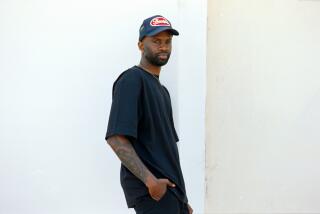Fathers and Sons
- Share via
It’s hard to imagine who could challenge Ellis Marsalis’ position as First Father of Jazz. There certainly are some well-known patresfamilias in the jazz world: Dewey Redman, father of saxophonist Joshua Redman, is one who immediately comes to mind; Ornette Coleman, whose son Denardo, a drummer, has worked with his father since he was barely a teenager, is another; and Dave Brubeck’s sons Darius (a keyboardist), Chris (a bassist and trombonist) and Danny (a drummer) have all performed with their father.
But with three highly successful, horn-playing offspring--Branford, Wynton and Delfeayo--as well as the highly praised, emerging young drummer Jason (who performs in the Ellis Marsalis Trio), the senior Marsalis would seem, for the moment, to have a lock on the First Father appellation.
Is that what gives Marsalis’ playing such a magisterial quality in his new trio album--half of which was recorded live, half in the studio? Probably not. Marsalis was a solid jazz artist when his talented brood was no more than a twinkle in his eye.
But it certainly is true that his life as a father and his work as an educator have tended to distract attention from his elegant skills as a pianist. At 63, Marsalis is a decade older than the justifiably much-honored pianist Kenny Barron, yet there are similarities in their skills--especially in the subtleties of touch, the capacity to extract fine nuances of color and timbre from the piano. Listen, for example, to the dancing quality of his lines on the blues “Mozartin’ ”; the rhapsodic, but never turgid, harmonies of “Friendship”; the crisp dynamic shifts of “Surrey With the Fringe on Top”; and the Monk-like articulation of “Tell Me.”
Jason Marsalis, who plays with astonishing maturity--in terms of his musical choices and his understanding of the role of drums in a piano trio--also produced the album. Clearly, Ellis Marsalis intends to do everything he can to make sure the dynasty continues.
Oscar Peterson and Benny Green, if not related by birth, can certainly be described as musical father and son. Although Green has shown signs of creative independence in the past year or so, his roots have always been firmly embedded in the rhythmically propulsive Peterson style--a connection furthered by Green’s lengthy association with Peterson’s onetime bassist, Ray Brown.
Hearing the pair together (with Brown on bass and Gregory Hutchinson on drums) is intriguing. The playing is irresistibly upbeat in a program that works its way comfortably through a program of familiar standards, with Green playing the role of eager acolyte, reacting and interacting, sometimes challenging his friend and mentor.
Peterson, who headlines a Hollywood Bowl concert on Aug. 19, is one of the surviving patriarchs of jazz piano. And age and infirmities aside, his playing is still a virtual definition of hard-driving, bop-based, swinging piano--best illustrated in his soloing on up-tempos such as “Limehouse Blues” and his highly personal double-time work in ballads such as “Here’s That Rainy Day.”
Given the circumstances, in which one pianist lays down accompanying harmonies while the other improvises, Peterson’s left-hand work--as a result of a stroke still not up to his usual high standard--is less of a problem than it is in his current solo outings. But Telarc is remiss in not identifying the stereo position or the solo sequence for each player.
*
Albums are rated on a scale of one star (poor) to four stars (excellent).
More to Read
The biggest entertainment stories
Get our big stories about Hollywood, film, television, music, arts, culture and more right in your inbox as soon as they publish.
You may occasionally receive promotional content from the Los Angeles Times.










